Less Than Two Weeks Out, Republicans Poised For Big Gains
Voters head to the polls in thirteen days, and current indications are that they'll be handing a big victory to the Republican Party.
With less than two weeks to go until people go to the polls, a new NBC/Wall Street Journal poll indicates that the GOP remains poised for big gains that are likely to give them control of at least one house of Congress:
WASHINGTON — Exactly two weeks until Election Day, Republicans remain poised to make significant midterm gains across the country, with 50 percent of likely voters preferring a GOP-controlled Congress, according to the latest NBC News/Wall Street Journal poll.
What’s more, Republicans appear to be benefiting from the public’s pessimistic mood, as approximately six in 10 registered voters think that the country is on the wrong track, and that the economy will get worse or stay the same in the next 12 months.
“Election Day is coming, the hurricane force has not diminished and it is going to hit the Democrats head on,” said Democratic pollster Peter D. Hart, who conducted the survey with Republican pollster Bill McInturff.
“It’s hard to say that the Democrats are facing anything less than a Category 4 hurricane,” Hart added.
Let’s take a look at the numbers:
In the survey, 50 percent of likely voters say they prefer a Republican-controlled Congress, versus 43 percent who want Democrats in charge.
Last month, Republicans held a 46 percent to 43 percent advantage among likely voters on this question.
The GOP’s current seven-point lead, McInturff observes, is on pace — historically — to result in a shift of power in Congress. “The Democrats, with two weeks left, are facing very, very difficult arithmetic.”
Yet among the wider universe of registered voters, Democrats hold a two-point edge, 46 to 44 percent, which is up from the 44 percent to 44 percent tie in September.
But Hart calls that lead “hollow,” because not all registered voters will participate, especially in a midterm election.
Indeed, among those expressing a high interest in voting this midterm season, Republicans hold a 13-point advantage on the generic ballot, 53 percent to 40 percent.
And among Tea Party supporters — who make up 35 percent of all likely voters in the poll — Republicans have a whopping 84 percent to 10 percent edge.
“Republicans are enthusiastically ready, willing and able to vote,” Hart said.
While there are some glimmers of hope for Democrats — specifically the fact that President Obama’s approval numbers are higher now than President’s Bush’s were in 2006 — the NBC/WSJ numbers are consistent with the general trend of the Generic Ballot, which has been generally negative for Democrats for weeks now:
And, perhaps, most significantly, the bellwether right track/wrong track poll numbers are at nearly the same level they were at on the eve of the 2008 elections:
When the public is dissatisfied, the party in power inevitably suffers. The mood of the public influences both who shows up at the polls, and who they vote for, and, this year, the Democrats are facing an electorate that is dissatisfied with the state of the economy, concerned about levels of spending unseen in American history, and, as always, of the opinion that those in power in Washington don’t have their best interests at heart.
So, where does this leave us?
As I noted yesterday, Larry Sabato, Charlie Cook, Scott Rasmussen, and Nate Silver are all forecasting Republican pickup in the House of between 45 and 55 seats, which would be more than enough to give them control of that chamber. In the Senate, things are a little more unclear. Silver and Sabato project a GOP gain of between 6-8 seats, but there are a bunch of toss-up states, including Colorado, Nevada, Washington, California, Illinois, and West Virginia. Recent polls suggest that there might be tightening in the Senate races in Kentucky and Pennsylvania. Also, as James Joyner noted this morning, we could be in for a surprise write-in victory in Alaska, although that wouldn’t impact the balance of power since Lisa Murkowksi has made clear she’ll continue to caucus with the GOP if she wins. And, of course, everything depends on turnout.
Nonetheless, there’s nothing in the polls to indicate that the projections of big Republican gains are overly optimistic, so I think it’s fairly reasonable to rely upon them at this point. The ground is likely to shift over the next thirteen days, though, so stay tuned.
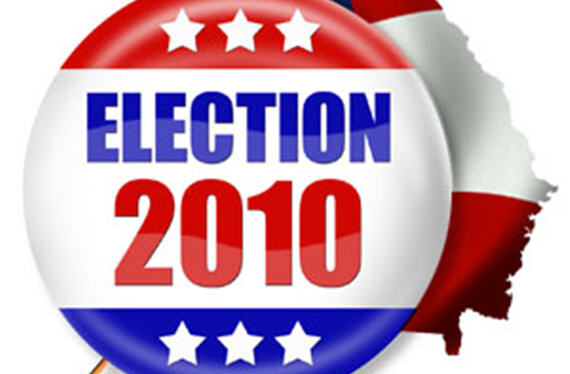
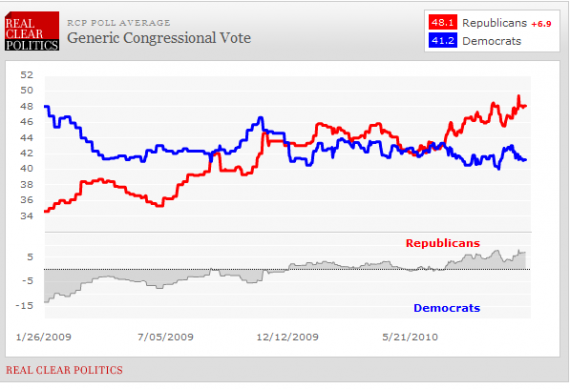
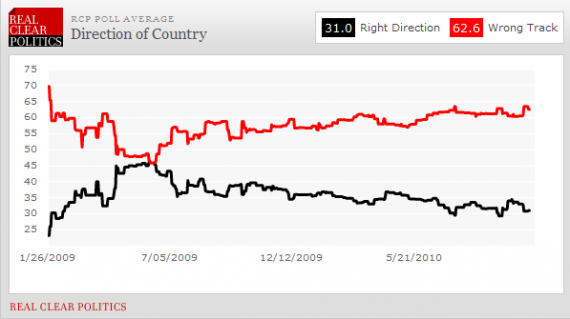


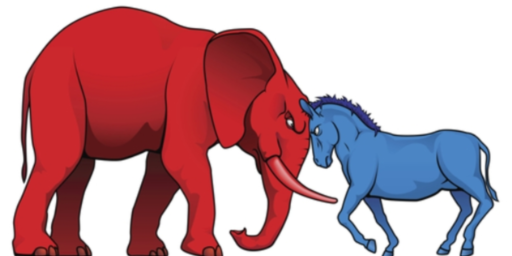
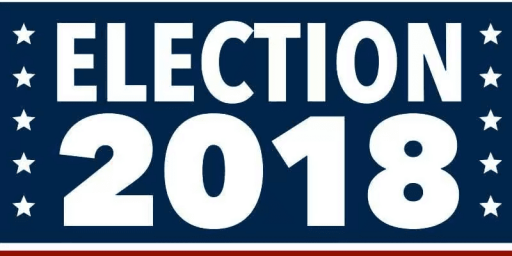

Don’t forget–though I’m damned if I know how to factor it in–that the polls actually opened a couple of days ago for many voters.
John,
Yea, early voting has started in many states — most significantly for Senate purposes in Nevada.
I’m not sure that anyone has developed a polling model that fully takes that into account yet.
Larry Sabato, Charlie Cook, Scott Rasmussen and Nate Silver are all wrong on the subject of how many House seats will switch. A 50 seat swing is the most unlikely outcome.
There will either be a wave or there won’t. If a wave occurs as the polls indicate, 80% to 90% of the seats in play will switch, giving the republicans a gain of 90+ seats. If the wave doesn’t materialize, the democrats will retain the House by 1 or 2 seats.
The experts are running their simulations with models that dampen wave projections due to averaging, plus they like to hedge their bets.
Re: Early voting…
My brother, a right-leaning Tea Party friendly Tancredo-supporting Iraq War vet, already mailed in his ballot. He told me that, surprisingly, he found himself voting for more Democrats than Republicans.
One factor I’ve seldom seen mentioned – 25% of households no longer have a landline phone, having gone solely mobile, and are therefore not available for polling.
I’ve heard these tend to be younger and more likely to be liberal, but I have no idea how this may or may not affect the election.
Herb: TP-friendly and Tancredo-supporting isn’t your typical Democratic demographic. Must be an interesting guy.
The factors that can give Dems hope are as follows, as far as I can see:
1) As c.red points out, there may well be a systematic bias in the polling, especially in the robocall outfits, given the move away from landlines amongst the public at large, and especially the lefty-leaning young folk.
2) Most polls, including this new one, show that, despite a years worth of hype to the contrary, the American people are evenly divided between the two parties, or actually prefer the Dems by a bit – it is only the “likely voter” screen which is defining this as a GOP wave. As a result, the Dems have no need to do any persuasion in these last two weeks, it is just a get out the vote effort. Take these “likely voter” numbers as the result if the Dems have a mediocre GOTV effort – the “registered voter” numbers would equal the result if they have a world-class GOTV effort. The actual results may well be somewhere inbetween.
3) A very underappreciated factor is early voting – not the earliness per se, but the fact that many people in the country will have a week or two during which they can get themselves down to the polling place. As a result, the “likely voter” screens may well be drawn far too tightly. Its one thing to have, or not have, the sufficient motivation to get to the polls on one particular Tuesday. If you have two weeks, you really don’t need to be all that motivated. There may be far more people actually voting than many of the pollsters assume.
If the no-landline polling thing is not a big problem for pollsters this election, I think it will be soon. I’ve taken a survey of my friends, and so far less than one in ten own a landline phone. Almost all of these people are politically liberal, and all will be voting this election if they haven’t already. I’m in my early-mid-30s, and all of these friends are between 25-37 years old. None of us has ever received a call from a political pollster.
While I know my own experience is not enough to go by, the fact is that almost all of the people I talked to had land lines four or five years ago. Unless my situation is unusual, and I don’t think it is, the pollsters are in for a very inaccurate election cycle one of these years.
Polling outfits are in fact making efforts to include cell phones in their polling. There’re certain structural difficulties in this (no cell phone directories, for instance), but they’re finding ways to actively poll cell-only users.
On that cellphone/landline thing:
Cell Phones and Election Polls: An Update
October 13, 2010
There’s charts and stuff accompanying the article if you’re interested.
Sorry, should’ve added that the article is from Pew Research.
And just think, the Republican victory would be even bigger if the partisan media actually got their facts right about statements made by candidates. Like the utter crap shoveled here yesterday about O’Donnell’s supposed faux pax in the church and state question. Turns out that Doug and others “version” of what happened wasn’t exactly accurate, eh?
I quote from the Washington Post (in a correction, after helping with the smear) regarding the exchange, ” She interrupted to say, “The First Amendment does? … So you’re telling me that the separation of church and state, the phrase ‘separation of church and state,’ is in the First Amendment?” In other words, she makes it perfectly clear what she’s questioning. Not that the Establishment Clause says what it says, but whether the phrase “separation of church and state” appears in the clause.
The portrayal and misinformation put out by the left on this matter is beyond despicable. One thing is certain; when the desperate left and their desperate accomplices need to lie about events to gain advantage… fear is in the air. And with good reason, because it is for exactly this type of garbage that the media has lost all meaningful credibility. And why the Progs are going to have their hindquarters handed to them in about two weeks…
Juneau,
What liberals (and even some here at OTB) don’t realize yet is that people will cast a vote for a Christine O’Donnell as a protest against the arrogance and condescension of the media.
When democrats can’t even win NY-22, they might as well give up.
http://www.nationalreview.com/campaign-spot/250454/tie-ny-22
jwest: I have to agree with you. Christine O’Donnell will indeed get a single vote, and it will probably be a protest vote.
What I am looking forward to is reading OTB on Wednesday, November 3rd. The shock of what is about to happen will not have fully been realized by many who post here. Guess we will understand only 20% of Americans identify themselves as liberal. That is one in five. No wonder there is a Tea Party. You guys act like it is the other way around. Most Americans lean the other way. When you have leaders of one party (Democrats) on the radical far left and govern from that postion. When the speaker of the house makes a statement concerning her feelins about private property and that it may be time to end such nonsense. We come to understand where you want to take us. The answer, as will be seen on November 2nd is NO.
What shock Zelsdorf ?
I fully expect to see a 45-55 seat gain in the House and a 5-7 seat gain in the Senate.
“I fully expect to see a 45-55 seat gain in the House and a 5-7 seat gain in the Senate.”
Yea, ho hum.
I think the big question is how many, if any, Tea Party Senate candidates win.
Doug,
I’m a bit taken aback that you would place your trust in people like Rasmussen, Cook and Silver instead of relying on my projections.
Without an advantage with white women, democrats are going to have a much tougher Nov 2 than they hoped for. Look for a 90+ seat gain for republicans.
http://www.washingtonpost.com/wp-dyn/content/article/2010/10/19/AR2010101905099.html
http://www.washingtonpost.com/wp-dyn/content/article/2010/10/20/AR2010102004269.html
I’m with the Onion. Dems will lose at least 450,000 seats in the House.
“I’m a bit taken aback that you would place your trust in people like Rasmussen, Cook and Silver instead of relying on my projections. ”
I’m relieved to see that “jwest” has been pulling our legs all this time. I was beginning to wonder about him/her…..